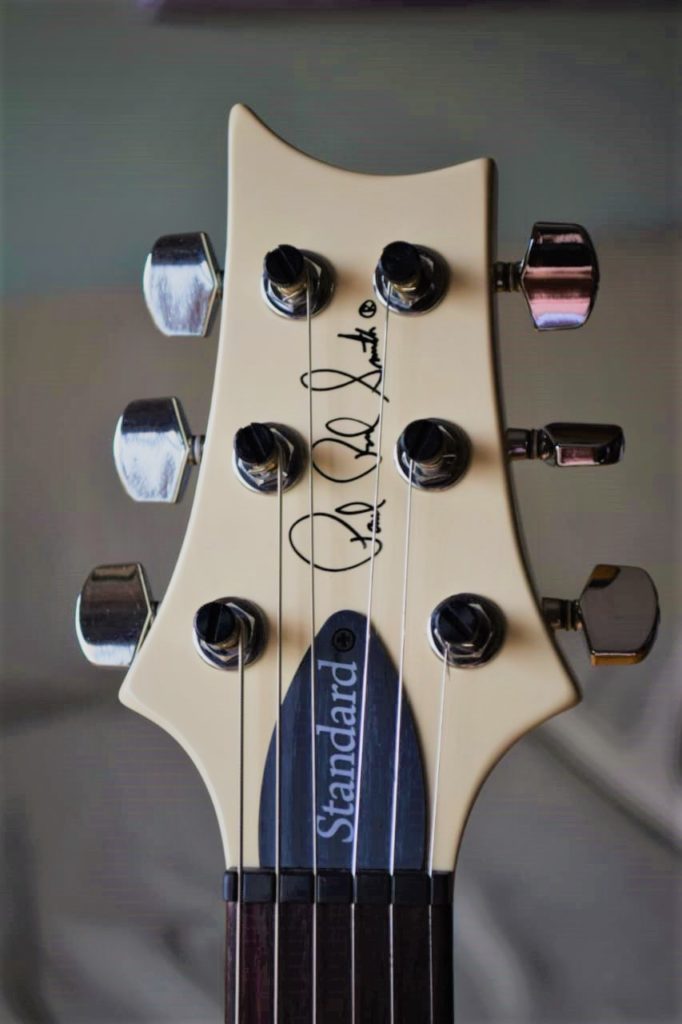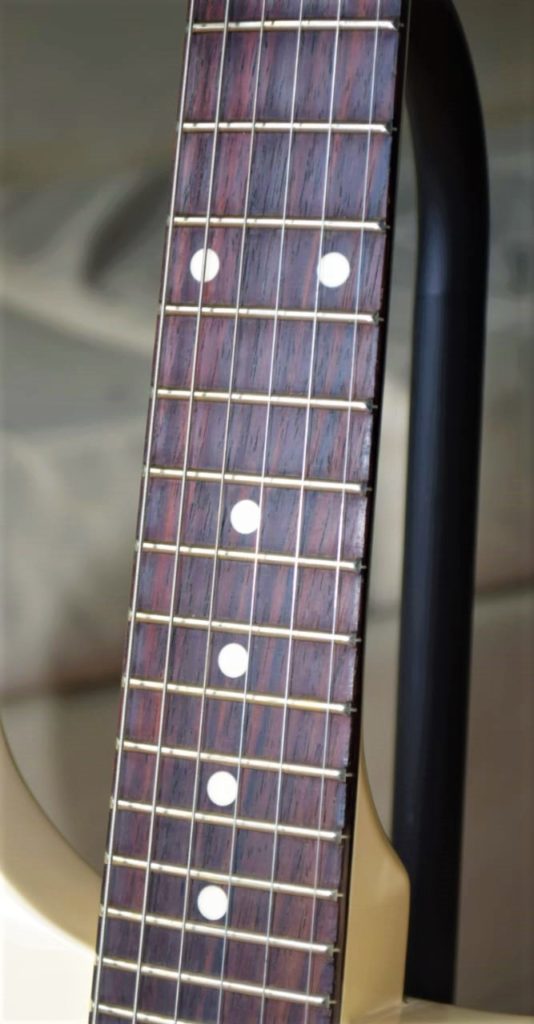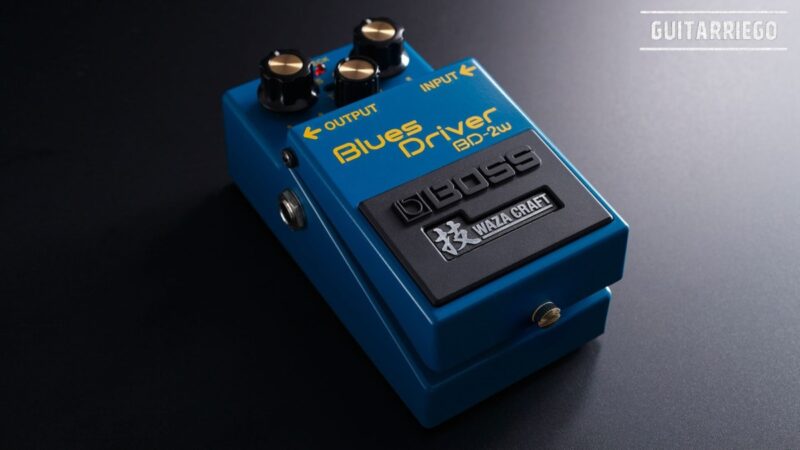PRS S2 Standard 24 review: A real Paul Reed Smith?

By Freddie Valle
PRS S2 Standard 24 guitar of the S2 Series, intermediate line of Paul Reed Smith, it’s a no-frills but it doesn’t sacrifice on performance.
S2 Series Features and Differences from PRS Core
The S2 series combines an American made guitar with Korean pickups, electronics and hardware. Thus, this instrument is manufactured in the Maryland plant, the same one that manufactures the Core series. Unlike PRS’s Core line, it uses a cheaper paint finish. Additionally, PRS S2 guitar necks are made with thinner mahogany planks that are complemented with pieces on the headstock and heel to complete the required thickness, while PRS Core guitar necks use a single piece of tonewood.

Another difference with the Core is that the PRS S2 have a thinner body with flat tops. Instead, the PRS Core have a thicker body and use Carved tops. Also, PRS Core usually have thick flamed maple tops which are very expensive.
Finally, the hardware, electronics and pickups of the S2 guitars are manufactured in Korea, where they manufacture the SE line -Student Edition-. The designs of the pickups, electronics and hardware are the same as those of the Core, and have a very high quality standard.
Quality and robustness of PRS S2 Standard 24
Beyond being an intermediate and moderately accessible line, the price of this PRS S2 Standard 24 model is around USD 1,400 in US online stores, it is still an instrument made in the USA. Thus, the tonewoods and build quality are American and PRS. Simply put, this guitar has exceptional quality.
The finishing details are impeccable. The fret crowning, like everything else, is done to perfection. While the guitar’s pickups perform more than decently, it is the only point that shows a clear area of improvement, but without a doubt, it can be played perfectly without changing anything, which will remain an excellent quality instrument.
Paul Reed Smith S2 hardware and electronics
As we already saw, the guitar hardware has the same design as the Core models. They work perfect. Also, the pegs and tremolo are very accurate.
The hardware is nickel, the tuning pegs PRS Low Mass. Finally, the bridge is PRS patented tremolo / vibrato design.
Guitar Tonewoods and Specifications PRS S2 Standard 24
Guitar body
The body of the PRS S2 Standard is made of Mahogany and has a flat top and a very ergonomic design. It is very important to highlight this, since it is very normal for non-top-of-the-range guitars to use cheap alternative woods to mahogany.
Guitar neck
The neck of the guitar is made of Mahogany with Indian Rosewood fretboard, and it has characteristics that are also found in the necks of the PRS Core line. Additionally, the classic PRS insert allows full access to the highest frets even at the 24th.
Fretboard profile according to the seller’s specifications is “Wide Fat”, while the current ones come with the “Regular Pattern”. Both are very similar with a slight difference at the height of the nut, where the “Wide Fat” is slightly wider. The “Wide Fat” is a profile similar to the Fender “Profile C”. It is a neck that has little shoulder, which makes it not feel thick.
Guitar’s fretboard radius is 10″, and it comes with Medium Jumbo frets. The crown and every detail are done to an excellent level of detail. The playability of the neck is outstanding, this is where you least notice the difference with a PRS Core guitar.
This guitar is finished in Antique White, has a great resonance and volume. Honestly, it shows extraordinary quality.
Similarities with a Gibson SG
In terms of dimensions, design, and placement of the pickups, this guitar is very similar to a Gibson SG. It just has a 25″ scale instead of the more common Gibson scale of 24.75″, which doesn’t seem like a big difference. Some highly trained ears may feel a little more Attack on PRS, and a little more Sustain on SG, but they are not significant differences. Where it deviates from the classic SG, it is in the pickups that are very different from the Gibson 490 or Classic ’57 that are usually found in the SG. While SG sounds can be achieved, this model really is a middle ground between Gibson and Fender audio.
Pickups PRS “S”
This model has got the 85/15 S, which is the Korean version of Paul Reed Smith’s first pickups, the 85/15. The “S” indicates that they are the pickups from the “Studient” lines: S2 and SE. They are pickups with a lot of output, especially for those who are used to vintage-spec pickups. Of course, they are spliteable.
They have a high level of treble, I would be encouraged to say that a little too much. But nothing that a tone pot can’t solve. In fact, on my guitar, the tone control is normally set between 6.5 and 7. This feature allows you to obtain tones with the classic Fender brightness, not only in splite mode, but also in humbucker mode.
So, I solved that excess of high frequencies by lowering the height of the pickups a bit and setting the Tone of the guitar to level 6/7. In case I want an extra definition and bright, I just have to turn up the tone. Instead, to get Gibson-like tones I set the tone to values between 5 and 6.

The pickups: the Achilles heel of the S2
It is worth clarifying that the guitar’s pickups work well. The thing is, given the outstanding performance of the entire guitar as a whole, the pickups are the only point where you feel it might be worth an upgrade. In my case, despite being someone who always seeks to improve my electric guitars by changing the Pickups, being pickups with totally different characteristics than the rest of my electric guitars have, I kept them to preserve a different tone. In case of changing them, I would only do it for other PRS, of the Core line, to maintain the essence of the PRS guitar. But perfectly, you could change them for PAF type guitar pickups to achieve a guitar similar to the SG, but more ergonomic.
In short, the guitar pickups are an opportunity for improvement. However, they do their job very well. They have good definition, removing excess treble, with the tone control you can achieve a balanced tone in frequencies. Therefore, you can leave the original pickups and the guitar will still work great.
Cover bag instead of hard case
The guitars of the S2 line instead of bringing hard cases like the PRS Core guitars do, they bring top quality cover bags.
Is it a real Paul Reed Smith guitar or not?
Undoubtedly, the essence of the PRS guitar is its quality standards of excellence and its attractive flamed maple tops “Ten Top” carved. Thus, the answer is yes and no. The build quality is extraordinary, it’s PRS. However, it does have Asian hardware, electronics and pickups, of good quality, but below those of the PRS Core guitars. Finally, it also doesn’t live up to the traditional concept of the flamboyant appearance of PRS guitars. Therefore, if you talk about a Paul Reed Smith guitar pure and simple, this guitar is left out. However, as we have already seen, the quality of this musical instrument is very high and one can enter the PRS world with this S2 Standard.
Conclusion and Opinion of PRS S2 Standard 24
In general, after having used it for several months, I can say that the Paul Reed Smith S2 Standard 24 guitar is an excellent musical instrument. Although for the fundamentalist of the brand it does not meet one of its main characteristics which is the extravagant aesthetics with impressive flamed tops, with carved shapes and striking colors; The S2 Standard 24 is a no-frills, understated PRS electric guitar. So for those of you who are used to playing Fender guitars like me, this won’t be a problem. In fact, for me the guitar in design and color is simply beautiful. However, for a PRS fan it is far from what he expects from Paul Reed Smith brand. But, this guitar is aimed at non-traditional Paul Reed Smith buyers; those with a more limited budget and / or focused on the functionality of the instrument.
Although the guitar has a mahogany neck, its bright pickups allow to obtain the bright and defined tone from a maple neck and when the tone control is closed it delivers audio similar to that of a Gibson SG. This makes this Paul Reed Smith electric guitar a super versatile and effective work tool.
Its build quality is excellent; only the guitar pickups have a regular performance. My conclusion is that it is a great option to access a PRS at an affordable value, sacrificing the shocking aesthetics of the PRS Core guitars.
Have you tried any PRS S2? What was your experience? You can share opinions or also chat about this and more with other musicians in our comments section.
For more information visit PRS Guitars.
Related Articles: Gibson LPJ 2014 review: Is it a Les Paul?














